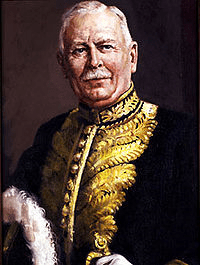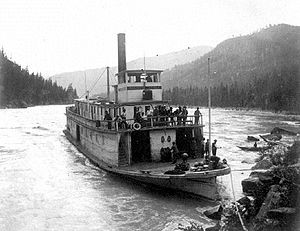Development of the Paradise Mine
History of the Paradise Mine (Part 3)
Robert Randolph Bruce (July 16, 1861 — February 21, 1942) was the 13th Lieutenant-Governor of British Columbia from 1926 to 1931. Bruce was born in Scotland and educated at the University of Glasgow where he studied engineering. He emigrated to the United States in 1887 before arriving shortly afterward in Canada to work for the Canadian Pacific Railway surveying various new railway lines across the country.

Randolph Robert Bruce – Bruce Creek, north of Paradise Bowl, flows out towards Wilmer and is named for him .
In 1897 Bruce settled in British Columbia to become a land developer. He purchased land from the railway and promoted it in England for settlement. Mr. H.C. Hammond, who was a partner in the financial and brokerage firm of Messrs. Osler & Hammond of Toronto, was interested in mining in the North-east Kootenay and arranged for Mr. Bruce to look after his interests in the East Kootenay. Impressed with the beauty of the country, the favourable climate, and the promising outlook for mining and the fertility of the soil for agriculture, Mr. Bruce determined to make the Windermere area of the Columbia Valley his home.
The three claims known as “Parradice”, “Royal Stag” and “Comstock” formed the nucleus of what become known as the Paradise Mine located at an altitude of almost 8000 feet, just above the tree line in Paradise Bowl. The mine workings eventually extended to a depth of 400 feet and the productive vein was 35 feet wide.
News of the value of the strike soon spread. Captain Gilbert Mitchell-Innes who represented John Taylor & Sons mining engineers of London secured a first option to purchase however the firm turned the property down. With the assistance of Tom Jones, Mr. Bruce secured an option for about $301,000. He formed a partnership with Mr. Fowler of Nelson and Mr. Hammond of Toronto and together they became the new owners of the Paradise Mine.
On receiving their shares of the purchase money the original prospectors, Watson and Jeffrey returned respectively to Manitoba and Ontario and Tom Jones bought a farm in Alberta. Jones could not settle into a farmers life and returned to the Columbia Valley and homesteaded the K2 Ranch on Westside Road south of Invermere.

The paddle-steamer North Star on the Columbia River circa 1902. This vessel transported Paradise ore downstream to the CPR train service at Golden, BC. From there it was railed to Revelstoke and then taken by steamer again to Trail. The entire journey could take up to two years.
Upon acquiring the Paradise Mine in 1900, Mr. Bruce extended the holdings to nine claims and acquired a large area of timber between Toby Creek and the headwaters of Spring Creek for construction, mine timbers and fuel purposes. To provide transportation, he constructed a first-class wagon road from the steamboat landing at Athalmer to Pinehurst (Jackpine) where a trail turned off to the mine. A good pack trail, subsequently converted to a sleigh road was constructed from Pinehurst to the mine, a distance of 8.25 miles.
By the time winter came the mine was shipping ore by rawhide and sleigh and before the spring thaw, 755 tons of ore had been delivered at the steamboat landing on the Columbia River. When navigation opened on the river the ore went north down the river to the CPR siding at Golden and was then carried by rail to the smelter at Trail, BC.
In 1903, Mr. VV. Fleet Robertson, Provincial Mineralogist, estimated the probable ore reserve of the Paradise Mine at 50,000 tons. After that 3 new veins were discovered.
The Paradise mine orebody is within the upper dolomite member of the Mount Nelson Formation. The host dolomite is light grey and fine grained with abundant black chert layers which preferentially replace cryptalgal structures and thin, carbonaceous black shale interbeds.
The orebody consists of a series of replacement mantos near the upper contact of the dolomite with the overlying sandstone of the Toby Formation. The ore in the upper levels of the mine was strongly oxidized and consisted mainly of lead carbonate (cerussite) with minor residual pyrite and sphalerite. At depth, the mineralization changed to mainly fracture controlled pyrite-galena-cerussite-sphalerite veins. Samples from the Paradise mine consist of massive panidiomorphic galena, sphalerite, pyrite, sucrosic cerussite and banded dolomite, galena, sphalerite and pyrite
Between 1901 and 1953, the mine produced about 22.9 million grams of silver, 7.2 million kilograms of lead, 3.6 million kilograms of zinc, 9999 kilograms of cadmium and 995 grams of gold from a total of 66,760 tonnes milled. (Source)
